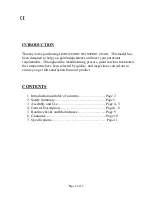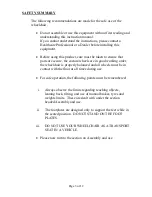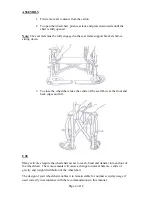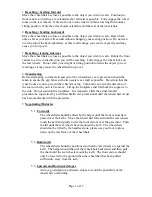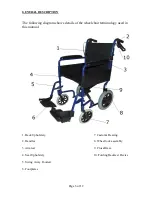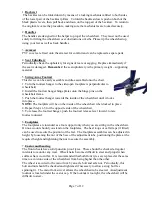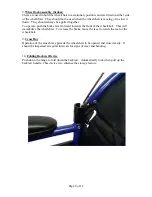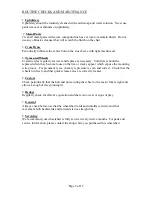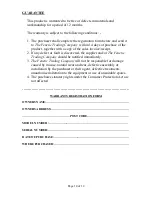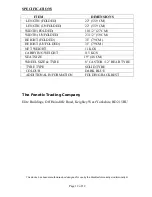
Page 7 of 12
1.
Backrest
The backrest can be folded down by means of a locking mechanism fitted to both sides
of the lower part of the backrest pillars. To fold the backrest down, push on both of the
black plastic levers, then pull back and down on the top part of the backrest. To return to
the original, reverse the procedure, making sure the mechanisms are locked securely.
2.
Handles
The handles are designed for the helper to propel the wheelchair. They must not be used
solely for lifting the wheelchair over obstructions or
kerbs
. Please tip the wheelchair up
using your feet as well as back handles.
3.
Armrest
PVC covers are fixed onto the armrest for comfort and can be replaced as spare parts.
4.
Seat Upholstery
Periodically check the upholstery for signs of tears or sagging. Replace immediately if
the seat is damaged.
Remember:
the seat upholstery is the primary weight
–
supporting
material.
5.
Swing Away Footrest
This device can be easily assemble and dis-assembled onto the chair.
1. Turn the footrest hanger to the side(open footplate is perpendicular to
wheelchair)
2. Install the footrest hanger hinge plates onto the hinge pins on the
wheelchair frame.
3. Push the footrest hanger towards the inside of the wheelchair until it locks
into place.
NOTE:
The footplate will be on the inside of the wheelchair when locked in place.
4. Repeat Steps 1-3 for the opposite side of the wheelchair.
5. To release the footrest hanger, push the footrest release lever inward, rotate
footrest outward.
6.
Footplates
The footplates are intended as a foot support only when you are sitting in the wheelchair.
On no account should you stand on the footplates. The heel loops or calf straps (if fitted)
can be used to secure the position of the feet. The footplate assemblies can be adjusted in
height by loosening the nut of the base of the adjustment tube, positioning the plate at the
required height and tightening the nut to secure the assembly.
7.
Castor and bearing
The front wheels have solid puncture proof tyres. These should be checked at regular
intervals to monitor any wear. Wheelchairs become difficult to steer and propel when
surfaces have worn flat. It is recommended that both front tyres are replaced at the same
time to avoid one side of the wheelchair from being higher than the other.
The wheel is secured to the castor fork by an axle bolt and axle nut. Periodically, this
bolt and nut should be checked and tightened if necessary to allow a snug but free
spinning fit. The castor fork swivel allows the wheelchair to be steered. An adjustment
locknut is located under the castor cap. If the locknut is too tight, the wheelchair will be
difficult to steer.-


